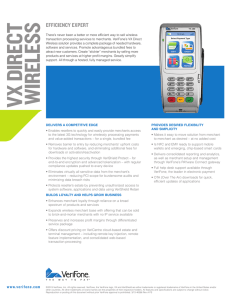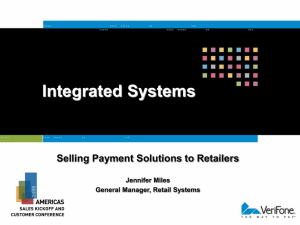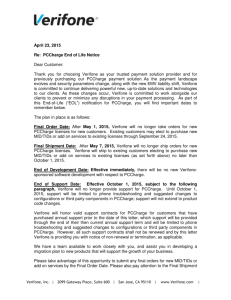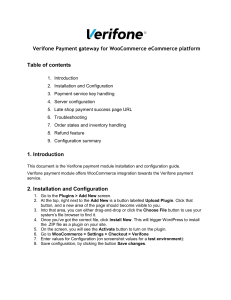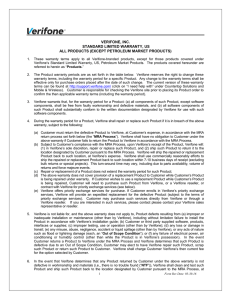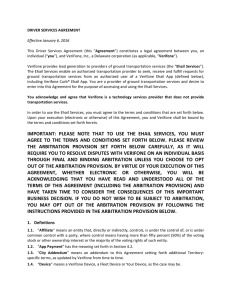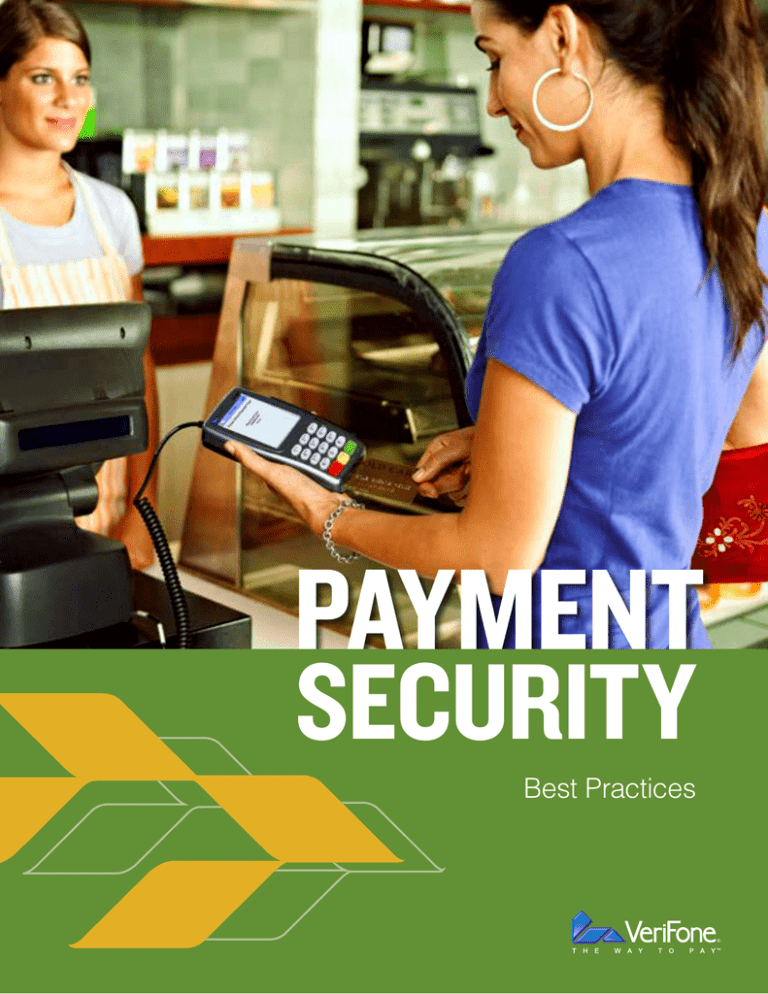
PAYMENT
SECURITY
Best Practices
At VeriFone, the protection of cardholder
information is a top priority.
To ensure merchants have secure payment solutions for their
customers, and to help protect merchants from penalties levied
by Payment Card Industry Data Security Standards in the event of
a breach, we have developed a series of best practices that apply
to traditional PIN pad devices, as well as today’s leading-edge
payment solutions that incorporate touch screens and advanced
wireless capabilities. These best practices will help retailers
determine whether an existing payment device has been tampered
with, while also outlining measures that can prevent security
breaches from happening in the first place.
Why should
merchants be
concerned
about security?
How do PIN
pad-based
security
breaches
happen?
The PCI Council adopted PIN Transaction Security (PTS) requirements because of
concerns that sophisticated criminals may have the resources to tamper with payment
devices and collect personal card data. Prior to the advent of PCI, the burden of
security lay almost completely on the retailer; but now, security requirements have
been standardized across the industry to make tampering progressively more difficult.
While this does mean that today’s PIN pad and POS devices are inherently more
secure than those developed pre-PCI, the simplest and often most effective
preventative measures are still those that retailers and merchants can incorporate
into routine operations.
Criminals are targeting less secure devices, which often pre-date PCI compliance
requirements – typically either tampering with an in-store device or obtaining the
same device that a retailer uses and modifying it for criminal purposes before
substituting the tampered device for the retailer’s device. The criminal then either
returns to retrieve the device to obtain the stolen information, or in some cases,
the device transmits personal card data wirelessly to another off-site computer.
Today’s newer devices incorporate a number of physical security precautions
designed to make it extremely difficult to modify a device. These precautions are
constantly tested and certified by independent labs.
How to Protect Your Business and Your Customers
Even with the physical security built into today’s devices, there are things
that merchants can do to significantly reduce the likelihood of a device
being subjected to tampering.
Physical Hardware
1. P
erform routine visual inspections of every device, looking for potential signs
of tampering. Also keep track of any operational difficulties that begin happening
on a regular basis. Some examples of things to look for include:
• Damaged or altered tamper seals
• Missing manufacturer labels
• Missing screws or screws with damaged heads
• Incorrect keyboard overlays
• External wires
• Holes in the device housing
• An electronic serial number that does not match the number printed
on the label on the bottom of the device
• A high number of mag-stripe read failures or debit card declines
• Difficulty inserting a chip and PIN card into the EMV slot
If you notice these or anything else out of the ordinary, stop using the device
immediately and disconnect it from the POS device or network, but do not power
it down. Immediately contact your bank or services provider, corporate security
team, or local authorities, and explain your concern. Continue to perform visual
inspections weekly in high-traffic areas and more frequently in locations with low
foot-traffic or PIN pad use.
2. S
tore spare devices under lock and key to prevent unauthorized removal.
Incorporate a shift change procedure to validate the inventory of devices at every
shift to ensure none have disappeared. Physically inspect devices before deploying
them for use.
3. Institute a procedure that requires all visiting repair technicians to sign in
with their name and company information and to track the serial numbers of
any devices that are installed, removed and/or replaced.
4. S
ecurely mount devices so that cables cannot be unplugged simply by turning
the device over. You may also want to consider installing locking stands to prevent
unauthorized removal.
Software
5. If your POS equipment is connected to a network via Ethernet,
ensure you have a working and updated network firewall where the connection
enters your location.
6. M
ake sure your POS equipment is protected by an encryption and
tokenization solution that encrypts credit card information at the point of
capture (swipe, tap, etc.). As added protection, you may want to install an
estate management solution that lets you monitor the status of all of your devices.
In addition to monitoring normal system functions (power, faulty hardware, etc.),
it can also provide alerts related to encryption and tokenization.
7. C
hange the device’s default admin password. These default passwords
become widely known. Contact your account executive if you need help
changing this password.
Purchase & Repair
8. O
nly obtain payment devices from a manufacturer or a manufacturer’s
authorized partner. Unauthorized resellers, which often may be found online at
sites such as eBay, may potentially sell devices that are already compromised,
whether intentionally or unwittingly.
9. F
or similar reasons, have your devices repaired by the manufacturer
or at an authorized manufacturer’s repair center that has completed a
key injection audit.
Having a response plan
in place before you suspect
you have a security issue
can help reduce confusion
and the amount of time
it takes to identify and
remediate a potential breach.
At a minimum,
this plan should
include:
1. S
teps to take to isolate all suspect payment systems to prevent further loss of
information and to preserve the attack method used for future investigation.
2. A
contact list: Local law enforcement, acquiring bank, your processor, a qualified
security assessor and any payment system vendors with which you work.
At VeriFone, we take a strong stance on security. With more than 30 years of experience,
we are leveraging our close relationships with retailers, banks and industry bodies to
develop and deliver the most dependable and secure payment solutions across all retail
environments. In fact, all VeriFone payment solutions, including our payment processing
software, conform to the most stringent security requirements outlined by the PCI
Council. Our ultimate goal is to make it impossible for fraudsters to commit card crime,
thereby allowing consumers to enjoy peace of mind when using their payment of choice.
Taken together, these best practices should significantly reduce the risk of device
tampering and compromise. Though the chance of a consumer becoming a victim of
card fraud remains low, we can never be too vigilant when it comes to customer data
security and brand reputation.
About VeriFone Systems, Inc. (www.verifone.com) VeriFone Systems, Inc. (“VeriFone”) (NYSE: PAY) is the global
leader in secure electronic payment solutions. VeriFone provides expertise, solutions and services that add value
to the point of sale with merchant-operated, consumer-facing and self-service payment systems for the financial,
retail, hospitality, petroleum, government and healthcare vertical markets. VeriFone solutions are designed to
meet the needs of merchants, processors and acquirers in developed and emerging economies worldwide.
www.verifone.com
© 2013 VeriFone, Inc. All rights reserved. VeriFone and the VeriFone logo are either trademarks or registered trademarks of VeriFone in the United States and/or other
countries. All other trademarks or brand names are the properties of their respective holders. All features and specifications are subject to change without notice.
Reproduction or posting of this document without prior VeriFone approval is prohibited. 5/13 46390 Rev A FS

